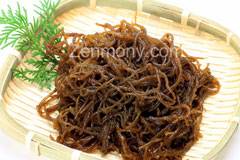| 2015 | APR | |||||||
| 2014 | JUL | OCT | DEC | |||||
| 2013 | JAN | FEB | APR | MAY | JUN | JUL | AUG | SEP |
| 2012 | SEP | OCT | NOV | DEC |
Sea algae (seaweeds) are the source of fucoidan
 The raw material for fucoidan is found in such algae types as kombu, mozuku, mekabu, and wakame. Amongst seaweeds and algae, it is only the brown algae and seaweeds that include considerable amounts of fucoidan. Fucoidan is made of sulfate groups, but since sulfate groups are fragile, it needs to be extracted so as not to disturb the structure. It is reported that the concentration of fucoidan is highest in mozuku alga, which is about 6 – 17 times that of kombu and about 3 times that of wakame. Fucoidan composes 90% of the polysaccharides found in Okinawa mozuku and pure Fucoidan can easily be extracted and created from it. The most of the seaweed that becomes the source of fucoidan is harvested in China, South Korea and Japan. Also, commercially produced are fucoidan products from Tonga. In Japan, more than 90% of mozuku is collected in Okinawa and approximately 90% of kombu is collected in Hokkaido. Wakame and mekabu are collected in various parts of Japan, having been collected in Sanriku, Kyushu, and near Naruto Strait. If you look at the amount of seaweed production worldwide, Asia accounted for more than 90% in 2009. Within Asia, the order of production volume is China, Japan, Korea, Thailand, and Vietnam. Dr. Kylin of Sweden discovered fucoidan, but production in Europe is low. The largest amount of production is in Norway, with the next being Spain, France, and England. Japan is also one of the only countries in the world to have actively incorporated seaweed into its diet. This seems to be related to the fact that other countries do not have as much of a background with using seaweed as food. When European and American people travel to Japan, that they are surprised when they see seaweed brought out as a garnish for sashimi is just one of the manifestations of differences in food culture. Please have a look at our fucoidan products.
The raw material for fucoidan is found in such algae types as kombu, mozuku, mekabu, and wakame. Amongst seaweeds and algae, it is only the brown algae and seaweeds that include considerable amounts of fucoidan. Fucoidan is made of sulfate groups, but since sulfate groups are fragile, it needs to be extracted so as not to disturb the structure. It is reported that the concentration of fucoidan is highest in mozuku alga, which is about 6 – 17 times that of kombu and about 3 times that of wakame. Fucoidan composes 90% of the polysaccharides found in Okinawa mozuku and pure Fucoidan can easily be extracted and created from it. The most of the seaweed that becomes the source of fucoidan is harvested in China, South Korea and Japan. Also, commercially produced are fucoidan products from Tonga. In Japan, more than 90% of mozuku is collected in Okinawa and approximately 90% of kombu is collected in Hokkaido. Wakame and mekabu are collected in various parts of Japan, having been collected in Sanriku, Kyushu, and near Naruto Strait. If you look at the amount of seaweed production worldwide, Asia accounted for more than 90% in 2009. Within Asia, the order of production volume is China, Japan, Korea, Thailand, and Vietnam. Dr. Kylin of Sweden discovered fucoidan, but production in Europe is low. The largest amount of production is in Norway, with the next being Spain, France, and England. Japan is also one of the only countries in the world to have actively incorporated seaweed into its diet. This seems to be related to the fact that other countries do not have as much of a background with using seaweed as food. When European and American people travel to Japan, that they are surprised when they see seaweed brought out as a garnish for sashimi is just one of the manifestations of differences in food culture. Please have a look at our fucoidan products.
Check out similar products here


